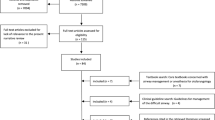Abstract
Purpose
To assess efficacy and prognostic factors of endoscopic balloon dilatation for the treatment of subglottic stenosis in children.
Methods
A retrospective review was performed on 49 pediatric patients with subglottic stenosis treated at the Shanghai Children’s Hospital between December 2017 and December 2021. Specific demographic data, type and severity of the stenosis, number of balloon dilatations and outcomes were recorded and analyzed.
Results
Forty-nine children (30 male, 19 female) were included in the study with a median age at diagnosis of 24 (13–36.5) months, of which 7 (14.3%) had received open laryngotracheal reconstruction previously. The degree of subglottic stenosis was grade I in six patients, grade II in 16 patients, grade III in 20 patients and grade IV in seven patients. After various numbers of balloon dilatations (1–7 times), 29 patients showed a good outcome (decannulation or prevention of tracheostomy) and the success rate in that series was 59.2%. Overall, prognosis of balloon dilatation was not dependent on pathogeny (congenital or acquired) or open surgical history(P > 0.05), but rather on the severity grade of stenosis and the number of dilatations (P < 0.05).
Conclusions
Endoscopic balloon dilatation can be safe and effective in the treatment of subglottic stenosis in children, except for more serious cases (grade IV). Open surgery should be considered if no significant improvement is observed after dilatation, especially after three or more dilatations.




Similar content being viewed by others
Availability of data and materials
The data supporting the results reported in the manuscript are available from the corresponding author upon reasonable request.
References
Walner DL, Loewen MS, Kimura RE (2001) Neonatal subglottic stenosis—incidence and trends. Laryngoscope 111(1):48–51. https://doi.org/10.1097/00005537-200101000-00009
Walner DL et al (1998) Gastroesophageal reflux in patients with subglottic stenosis. Arch Otolaryngol Head Neck Surg 124(5):551–555. https://doi.org/10.1001/archotol.124.5.551
Wright CD et al (2019) Postintubation tracheal stenosis: management and results 1993 to 2017. Ann Thorac Surg 108(5):1471–1477. https://doi.org/10.1016/j.athoracsur.2019.05.050
Monnier P, Lang F, Savary M (2003) Partial cricotracheal resection for pediatric subglottic stenosis: a single institution’s experience in 60 cases. Eur Arch Otorhinolaryngol 260(6):295–297. https://doi.org/10.1007/s00405-002-0465-y
Jaquet Y, Lang F, Pilloud R, Savary M, Monnier P (2005) Partial cricotracheal resection for pediatric subglottic stenosis: long-term outcome in 57 patients. J Thorac Cardiovasc Surg 130(3):726–732. https://doi.org/10.1016/j.jtcvs.2005.04.020
Wentzel JL et al (2014) Balloon laryngoplasty for pediatric laryngeal stenosis: case series and systematic review. Laryngoscope 124(7):1707–1712. https://doi.org/10.1002/lary.24524
Smith MM, Cotton RT (2018) Diagnosis and management of laryngotracheal stenosis. Expert Rev Respir Med 12(8):709–717. https://doi.org/10.1080/17476348.2018.1495564
Blanchard M et al (2014) Management specificities of congenital laryngeal stenosis: external and endoscopic approaches. Laryngoscope 124(4):1013–1018. https://doi.org/10.1002/lary.24373
Redondo-Sedano J et al (2019) Laryngeal stenosis in children: types, grades and treatment strategies. J Pediatr Surg 54(9):1933–1937. https://doi.org/10.1016/j.jpedsurg.2018.09.027
Jefferson ND, Cohen AP, Rutter MJ (2016) Subglottic stenosis. Semin Pediatr Surg 25(3):138–143. https://doi.org/10.1053/j.sempedsurg.2016.02.006
Narcy P et al (1990) Surgical treatment for laryngotracheal stenosis in the pediatric patient. Arch Otolaryngol Head Neck Surg 116(9):1047–1050. https://doi.org/10.1001/archotol.1990.01870090063009
Gunaydin RO, Suslu N, Bajin MD, Kuscu O, Yilmaz T, Unal OF et al (2014) Endolaryngeal dilatation versus laryngotracheal reconstruction in the primary management of subglottic stenosis. Int J Pediatr Otorhinolaryngol 78(8):1332–1336. https://doi.org/10.1016/j.ijporl.2014.05.022
Guarisco JL, Yang CJ (2013) Balloon dilation in the management of severe airway stenosis in children and adolescents. J Pediatr Surg 48(8):1676–1681. https://doi.org/10.1016/j.jpedsurg.2012.12.035
Hautefort C et al (2012) Balloon dilation laryngoplasty for subglottic stenosis in children: eight years’ experience. Arch Otolaryngol Head Neck Surg 138(3):235–240. https://doi.org/10.1001/archoto.2011.1439
Quesnel AM et al (2011) Minimally invasive endoscopic management of subglottic stenosis in children: success and failure. Int J Pediatr Otorhinolaryngol 75(5):652–656. https://doi.org/10.1016/j.ijporl.2011.02.002
Koempel JA, Cotton RT (2008) History of pediatric laryngotracheal reconstruction. Otolaryngol Clin North Am 41(5):825–835. https://doi.org/10.1016/j.otc.2008.04.014
Hu B, Wang J, Chen J, Zhao L, Li X (2021) The heterogeneity of fibroblasts in laryngotracheal stenosis and skin hypertrophic scar in pediatric patients. Int J Pediatr Otorhinolaryngol 145:110709. https://doi.org/10.1016/j.ijporl.2021.110709
Maresh A et al (2014) A comparative analysis of open surgery vs endoscopic balloon dilation for pediatric subglottic stenosis. JAMA Otolaryngol Head Neck Surg 140(10):901–905. https://doi.org/10.1001/jamaoto.2014.1742
Mirabile L et al (2010) Endoscopic anterior cricoid split and balloon dilation in pediatric subglottic stenosis. Int J Pediatr Otorhinolaryngol 74(12):1409–1414. https://doi.org/10.1016/j.ijporl.2010.09.020
Edmondson NE, Bent JR (2010) Serial intralesional steroid injection combined with balloon dilation as an alternative to open repair of subglottic stenosis. Int J Pediatr Otorhinolaryngol 74(9):1078–1081. https://doi.org/10.1016/j.ijporl.2010.05.027
Acknowledgements
We are very grateful to all members of Department of Otolaryngology-Head and Neck Surgery, Shanghai Children’s Hospital, School of medicine, Shanghai Jiao Tong University.
Funding
The study was supported by Shanghai Shen-kang Hospital Development Centre (No: SHDC12019X21).
Author information
Authors and Affiliations
Contributions
YZ: conceptualization, methodology, software, validation, formal analysis, data curation, writing—original draft. HX: methodology, validation, formal analysis. XL: conceptualization, methodology, validation, writing—review and editing, funding acquisition. Each of the authors has contributed to and approved the final version of this manuscript.
Corresponding author
Ethics declarations
Conflict of interest
The authors declare that there is no conflict of interest regarding the publication of this paper.
Ethical approval
Approval was obtained from the ethics committee of Shanghai Children’s Hospital. The procedures used in this study adhere to the tenets of the Declaration of Helsinki.
Consent to participate
Informed consent was obtained from all individual participants included in the study.
Additional information
Publisher's Note
Springer Nature remains neutral with regard to jurisdictional claims in published maps and institutional affiliations.
Rights and permissions
Springer Nature or its licensor (e.g. a society or other partner) holds exclusive rights to this article under a publishing agreement with the author(s) or other rightsholder(s); author self-archiving of the accepted manuscript version of this article is solely governed by the terms of such publishing agreement and applicable law.
About this article
Cite this article
Zheng, Y., Xu, H. & Li, X. Management of balloon dilatation in cases of subglottic stenosis in children: success and failure. Eur Arch Otorhinolaryngol 280, 2859–2864 (2023). https://doi.org/10.1007/s00405-023-07826-z
Received:
Accepted:
Published:
Issue Date:
DOI: https://doi.org/10.1007/s00405-023-07826-z




